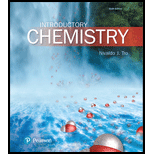
Interpretation: The expected boiling point and freezing point of sugar solution are to be calculated, the deviation of boiling point of syrup and boiling point of pure water is to be explained and also the freezing of syrup at
Concept Introduction: Colligative properties of a solution depend upon the amount of solute present in the solution irrespective of its nature.
They are of 4 types, freezing point depression, boiling point elevation, lowering of vapor pressure and osmotic pressure.
On addition of a non-volatile solute, the physical properties of a pure solvent get altered and extends the temperature range over which it can remain a liquid.
The molality of any solution can be given as:
The freezing point depression of a solution is given by the expression:
Want to see the full answer?
Check out a sample textbook solution
Chapter 13 Solutions
Introductory Chemistry (6th Edition)
- Cooking A cook prepares a solution for boiling by adding12.5 g of NaCl to a pot holding 0.750 L of water. Atwhat temperature should the solution in the pot boil?Use Table 14.5 for needed data.arrow_forwardMaple syrup sap is 3% sugar (sucrose) and 97% water bymass. Maple syrup is produced by heating the sap toevaporate a certain amount of the water. (a) Describe what happens to the composition and boilingpoint of the solution as evaporation takes place. (b) A rule of thumb among maple syrup producers is thatthe finished syrup should boil about 4 C higher than theoriginal sap being boiled. Explain the chemistry behindthis guideline. (c) If the finished product boils 4 C higher than the originalsap, calculate the concentration of sugar in the finalproduct. Assume that sugar is the only solute and theoperation is done at 1 atm pressure.arrow_forwardRefer to Figure 13.10 ( Sec. 13-4b) to answer these questions. (a) Does a saturated solution occur when 65.0 g LiCl is present in 100 g H2O at 40 C? Explain your answer. (b) Consider a solution that contains 95.0 g LiCl in 100 g H2O at 40 C. Is the solution unsaturated, saturated, or supersaturated? Explain your answer. (c) Consider a solution that contains 50. g Li2SO4 in 200. g H2O at 50 C. Is this solution unsaturated, saturated, or supersaturated? Explain your answer. Figure 13.10 Solubility of ionic compounds versus temperature.arrow_forward
- Starch contains CC, CH, CO, and OH bonds. Hydrocarbons have only CC and CH bonds. Both starch and hydrocarbons can form colloidal dispersions in water. Which dispersion is classified as hydrophobic? Which is hydrophilic? Explain briefly.arrow_forwardA sample of water contains 0.010 ppm lead ions, Pb2+. (a) Calculate the mass of lead ions per liter in this solution.(Assume the density of the water solution is 1.0 g/mL.) (b) Calculate the mass fraction of lead in ppb.arrow_forwardFor each of the following pairs of solutions, select the solution for which solute solubility is greatest. a. Oxygen gas in water with P = 1 atm and T = 10C Oxygen gas in water with P = 1 atm and T = 20C b. Nitrogen gas in water with P = 2 atm and T = 50C Nitrogen gas in water with P = 1 atm and T = 70C c. Table salt in water with P = 1 atm and T = 40C Table salt in water with P = 1 atm and T = 70C d. Table sugar in water with P = 3 atm and T = 30C Table sugar in water with P = 1 atm and T = 80Carrow_forward
- Refer to Figure 13.10 ( Sec. 13-4b) to determine whether these situations would result in an unsaturated, saturated, or supersaturated solution. 120. g RbCl is added to 100. g H2O at 50 °C. 30. g KCl is dissolved in 100. g H2O at 70 °C. 20. g NaCl is dissolved in 50. g H2O at 60 °C. Figure 13.10 Solubility of ionic compounds versus temperature.arrow_forwardFor each of the following pairs of solutions, select the solution for which solute solubility is greatest. a. Ammonia gas in water with P = 1 atm and T = 50C Ammonia gas in water with P = 1 atm and T = 90C b. Carbon dioxide gas in water with P = 2 atm and T = 50C Carbon dioxide gas in water with P = 1 atm and T = 50C c. Table salt in water with P = 1 atm and T = 60C Table salt in water with P = 1 atm and T = 50C d. Table sugar in water with P = 2 atm and T = 40C Table sugar in water with P = 1 atm and T = 70Carrow_forward
- Chemistry: Matter and ChangeChemistryISBN:9780078746376Author:Dinah Zike, Laurel Dingrando, Nicholas Hainen, Cheryl WistromPublisher:Glencoe/McGraw-Hill School Pub Co
 Chemistry: The Molecular ScienceChemistryISBN:9781285199047Author:John W. Moore, Conrad L. StanitskiPublisher:Cengage Learning
Chemistry: The Molecular ScienceChemistryISBN:9781285199047Author:John W. Moore, Conrad L. StanitskiPublisher:Cengage Learning General, Organic, and Biological ChemistryChemistryISBN:9781285853918Author:H. Stephen StokerPublisher:Cengage Learning
General, Organic, and Biological ChemistryChemistryISBN:9781285853918Author:H. Stephen StokerPublisher:Cengage Learning  ChemistryChemistryISBN:9781305957404Author:Steven S. Zumdahl, Susan A. Zumdahl, Donald J. DeCostePublisher:Cengage Learning
ChemistryChemistryISBN:9781305957404Author:Steven S. Zumdahl, Susan A. Zumdahl, Donald J. DeCostePublisher:Cengage Learning





